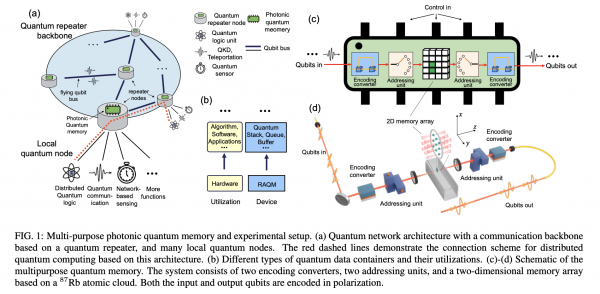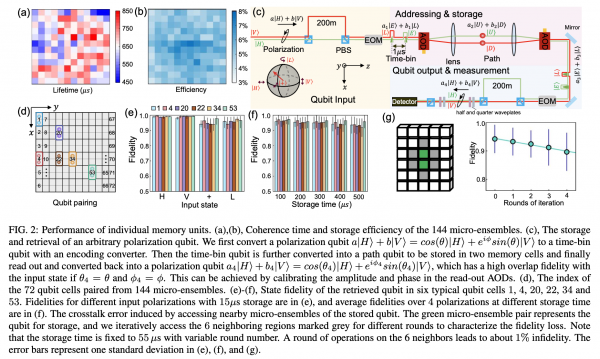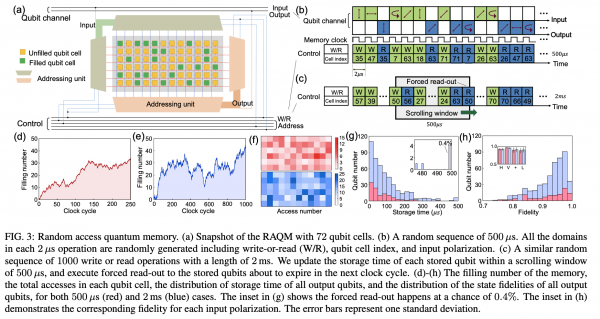Researchers from the Center for Quantum Information (CQI), Tsinghua University, Beijing, have reported successful development and testing of a new programmable quantum memory framework. “This work provides a promising platform for the implementation of quantum repeaters, quantum network, and networked quantum computation,” say the researchers in their paper published today in APS journal, Physical Review X.
During tests, the quantum memory stored 72 optical qubits — quantum bits of information analogous to the binary digits (bits) used in classical computing — and conducted 1,000 consecutive read-or-write operations in programmable style. The unit could also queue, stack, and buffer incoming information, which are three actions that classical computers rely on when interfacing with the internet. These results represent a performance two orders of magnitude larger than previous records for quantum memory.
The latest work is another step forward for quantum network development. Work on quantum memory and quantum networking has intensified recently with many approaches to quantum memory and repeater development underway. The Tsinghua researchers* note that substantial advances have been made for the realization of various quantum memories including photonic quantum memory with long coherence time based on atomic or spin ensembles, single atoms or ions, and single vacancy center (NV-vacancy).
The problem, they add, “To achieve a reasonable entangling rate over a metropolitan size of 100 km via the quantum repeater protocol, one has to combine long coherence time, large memory capacity, and high-fidelity operations altogether. Although there are demonstrations for each individual technique, how to make them compatible with each other and integrate all these elements into a single quantum memory setup remains a challenging goal in experiment.”
There are, of course, many groups racing to develop effective quantum networks. The U.S. Department of Energy, for example, issued a report, Building a Nationwide Quantum Internet, back in 2020. Lot’s of progress has been made and several cities have ongoing efforts, including, for example, Chicago, NYC, and Chattanooga. Likewise a few major cloud providers have similar efforts. For example, AWS has a center for quantum networking development, in Boston. Building effective and performant repeaters is one of the major challenges still impeding these efforts. (See HPCwire coverage, What’s Needed to Deliver the Nationwide Quantum Internet Blueprint.)
The Tsinghua University researchers’ approach promises to help overcome these challenges. Here’s the abstract from their paper (Realization of a programmable multi-purpose photonic quantum memory with over-thousand qubit manipulations):
“Quantum networks can enable various applications such as distributed quantum computing, long-distance quantum communication, and network-based quantum sensing with unprecedented performances. One of the most important building blocks for a quantum network is a photonic quantum memory which serves as the interface between the communication channel and the local functional unit. A programmable quantum memory which can process a large stream of flying qubits and fulfill the requirements of multiple core functions in a quantum network is still to-be-realized.
“Here we report a high-performance quantum memory which can simultaneously store 72 optical qubits carried by 144 spatially separated atomic ensembles and support up to a thousand consecutive write or read operations in a random access way, two orders of magnitude larger than the previous record. Due to the built-in programmability, this quantum memory can be adapted on-demand for several functions. As example applications, we realize quantum queue, stack, and buffer which closely resemble the counterpart devices for classical information processing. We further demonstrate the storage and reshuffle of 4 entangled pairs of photonic pulses with probabilistic arrival time and arbitrary release order via the memory, which is an essential requirement for the realization of quantum repeaters and efficient routing in quantum networks. Realization of this multi-purpose programmable quantum memory thus constitutes a key enabling building block for future large-scale fully-functional quantum networks.”
Bottom line: The photonic quantum memory implemented here is scalable, long-lived, fully-controllable, and combines unprecedented versatility, provides key enabling ingredients for the implementation of quantum repeaters and large-scale quantum networks.
Looking ahead, the researchers say, “In the future, it is possible to further improve the coherence time to over 0.1s and efficiency above 0.5 with much higher optical depth by loading the atoms into an optical lattice array, which will greatly improve the performance of photonic quantum logic. We can also exploit wavelength conversion techniques to achieve a quantum repeater network for long-distance communication. Finally, if in-memory quantum gates are further equipped via Rydberg interactions or spin superexchange, a nearly universal platform can be realized which will support the implementation of fully-connected quantum logic, error-corrected quantum network, or even a global quantum internet.”
As always, it’s best to read the paper directly.
Link to paper, https://journals.aps.org/prx/abstract/10.1103/PhysRevX.14.021018
Authors* Sheng Zhang,1 Jixuan Shi,1 Zhaibin Cui,1 Ye Wang,1 Yukai Wu,1, 2 Luming Duan,1, 2 , ∗ and Yunfei Pu1, 2 , † 1Center for Quantum Information, Institute for Interdisciplinary Information Sciences, Tsinghua University, Beijing 100084, PR China
2Hefei National Laboratory, Hefei 230088, PR China
































































